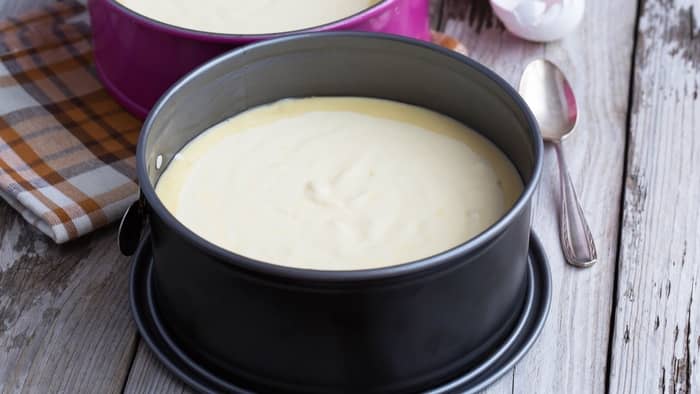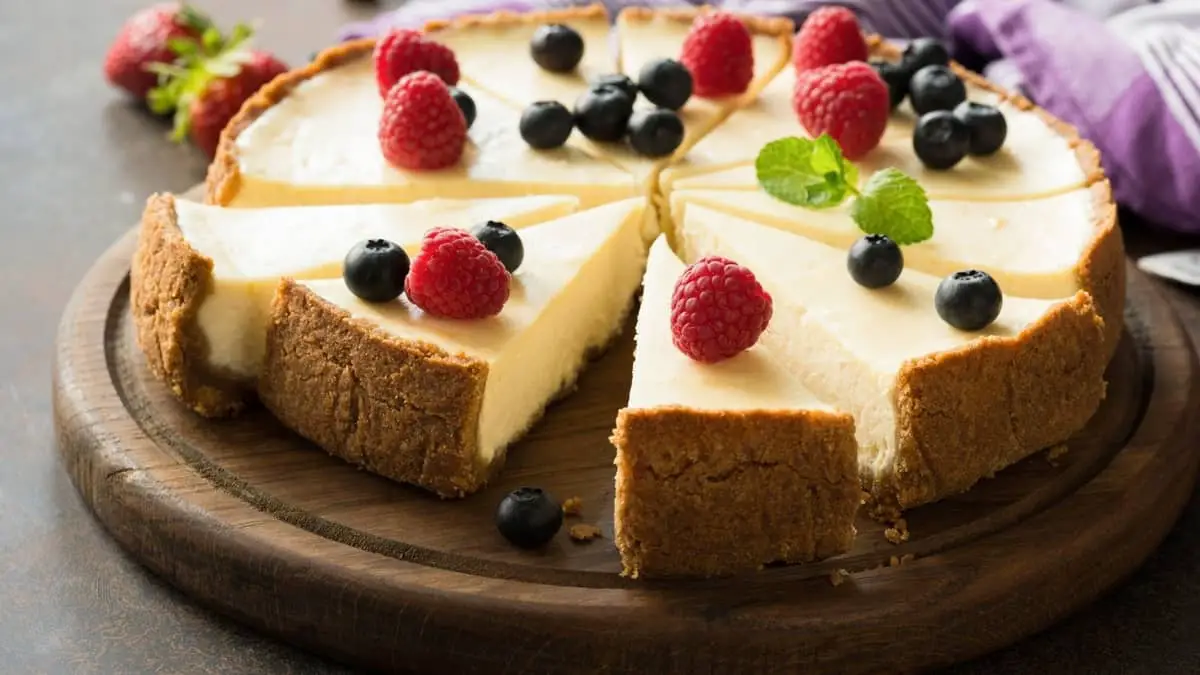Last Updated on April 22, 2022
Cheesecakes are an amazing dessert, but they can be tricky to get just right. The cheesecake jiggle test is one way to tell if your cheesecake is done baking. It can allow you to tell if your cheesecake is done, or if it needs more time in the oven.
It is important to get a cheesecake done just right, as too long in the oven it will become dry, and not long enough it can fall apart when you slice it. Fortunately, there are a few ways you can test to ensure your cheesecake is fully baked and ready to enjoy. One of the best ways to check doneness is using the jiggle test.
What Is The Cheesecake Jiggle Test?
The cheesecake jiggle test is a common method to tell if a cheesecake is fully baked. If a small circle in the cheesecake jiggles, that means that it is all done. If all of the cheesecake jiggles, it means that it needs more time in the oven.
A slight jiggle in the middle means the cheesecake is fully cooked and is not raw. As the cheesecake cools, it will fully set, giving you a lovely smooth surface. If the cheesecake does not jiggle at all, then it is probably overbaked.

How to do the cheesecake jiggle test
To do the cheesecake jiggle test, check the cheesecake after the timer goes off. Open the oven and while wearing oven mitts, gently shake the cheesecake to see if the middle shakes.
Instead of shaking the cheesecake, you can lightly tap the sides of the pan with a wooden spoon. By tapping it, you can see how much the cheesecake can jiggle.
If just a small circle of the cheesecake jiggles, then the cheesecake is ready to start the cooling process. In most cases, the cheesecake will cool in the oven, with it off, for around one hour to prevent cracking.
Is the cheesecake jiggle test accurate?
The cheesecake jiggle test is one of the most accurate ways to see if your cheesecake is fully baked. It is a simple yet effective way to tell if your cheesecake is fully baked. Just a slight jiggle indicates a wonderfully baked cheesecake, however, it is very important to not skip the cooling process as this is when the cheesecake sets up.
Other Ways To Test Doneness In Cheesecake
Though the jiggle test is one of the best ways to check if the cheesecake is done, there are other ways as well. These methods allow you to see whether or not your cheesecake needs more time in the oven.
Touch
You can use touch as a way to find out if your cheesecake is done, just be careful because the cheesecake will be hot. With clean hands, gently touch the middle of the cheesecake. The cheesecake should be slightly firm and should not cling to your hand if it is fully baked.
Appearance
The cheesecake should have a pale ivory color when it is fully baked. The edges may be slightly golden brown, but you don’t want too much browning as that will likely mean your cheesecake is overbaked.
Temperature
Though not the best way to check if a cheesecake is done, you can use a thermometer to see if your cheesecake is fully baked. Take the temperature in the middle of the cheesecake and if it reads between 150 to 155 degrees Fahrenheit, it is done. The downfall to this method is that you will end up with a hole in your cheesecake.
Tips For Baking The Best Cheesecake
When baking a cheesecake, you want it to come out smooth and creamy. A cheesecake that is properly prepared and baked will have a slight jiggle when done. Here are some handy tips to bake the best cheesecake possible.
Use room temperature ingredients
One of the most important aspects to making a cheesecake is to use room temperature ingredients. Using cold cream cheese can lead to curdling, which can cause an unpleasant texture in your cheesecake. In addition, be sure not to over mix your cheesecake batter.
Use a water bath
A water bath is a great method to use to achieve a smooth, creamy cheesecake. In addition, a water bath decreases the chances of cracking in your cheesecake, creates a more even bake, and prevents your cheesecake from drying out.
To create a water bath, place your cheesecake pan in a large pan of boiling water in the oven. Be sure to wrap your cheesecake pan in aluminum foil or place it in an oven-safe bag to prevent water from leaking into the pan.
Springform Pan Set of 3 (4″, 7″, 9″) – Non-stick Leakproof Baking Set – Cake, Cheesecake
Don’t open the oven to check on it
Though it can be tempting, don’t open the oven to check on your cheesecake as it bakes. Opening the oven can cause heat to escape and cause your cheesecake to not bake correctly.
Let it fully cool
Though it can be tempting to eat your cheesecake as soon as possible, it is very important to let it fully cool first. Cheesecakes need to cool gradually to prevent cracking and allow them to properly set. It is generally best to turn off your oven once your cheesecake is done baking and let it cool inside.
A Jiggly Cheesecake
When a cheesecake is fully baked, the middle will jiggle slightly. You can test for a jiggle by shaking the cheesecake while wearing oven mitts or by tapping it with a wooden spoon.
Do you have any questions regarding the cheesecake jiggle test? If so, please ask your cheesecake questions in the comments below.
FAQs
How Do I Know if My Cheesecake is Jiggly?
To test if your cheesecake is jiggly, shake it slightly while wearing oven mitts or tap it with a wooden spoon. The movement should let you see your cheesecake jiggle.
How Do You Test Cheesecake for Doneness?
The best way to test a cheesecake for doneness is to slightly shake it. If it is done, the center of the cheesecake will jiggly slightly.
What Do I Do if My Cheesecake Doesn't Jiggle?
If your cheesecake doesn't jiggle, it is likely overbaked. Turn off the oven and let it cool fully. It will still be alright to eat, but it may be a bit dry.
How Do I Make My Cheesecake Firmer?
To make your cheesecake firmer, allow it to cool in the oven with the oven turned off. Then, let it chill in the fridge for a few hours before serving.

Ever since she was a young girl, Anna has been a lover of desserts. As an adult, she enjoys
baking a variety of desserts from cakes, cookies, brownies, bread, and more from scratch. She
enjoys sharing her passion for baking with others who also have a sweet tooth. From properly
measuring ingredients to making sure they are the correct temperature, Anna knows the
importance small details can make in baking. She wants to share her experience with others in
hopes they can make the most delicious baked goods. When she’s not busy blogging, Anna
enjoys trying new recipes in the kitchen.


